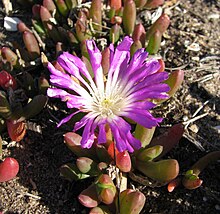|
Disphyma
Disphyma is a genus of flowering plants in the family Aizoaceae that are native to New Zealand, Australia and southern Africa. Plants in this genus are prostrate, annual or short-lived perennial shrubs with succulent leaves and daisy-like flowers arranged singly on the ends of shoots with petal-like staminodes, many stamens and usually five styles. DescriptionPlants in the genus Disphyma are prostrate, annual plants or short-lived perennials with branches that root at nodes. The leaves are arranged alternately and fused at the base, succulent and round to more or less triangular in cross-section. The flowers are usually arranged singly, sometimes in pairs or three, on the ends of branches or on short side shoots, each flower on a pedicel up to 100 mm (3.9 in) long. The perianth is tube-shaped with five sepals, two larger and leaf-like and three smaller, slightly succulent and not leaf-like. There are many petal-like, purplish staminodes in two rows and many stamens in four or five rows. The ovary is inferior and there are usually five styles. The fruit is a capsule.[1][2] TaxonomyThe genus Disphyma was first formally described in 1925 by N. E. Brown in The Gardeners' Chronicle.[3][4] As at October 2020, Plants of the World Online accepts four species:
Plants of the World Online also accepts two subspecies:
References
|
||||||||||||||||||||||||||
